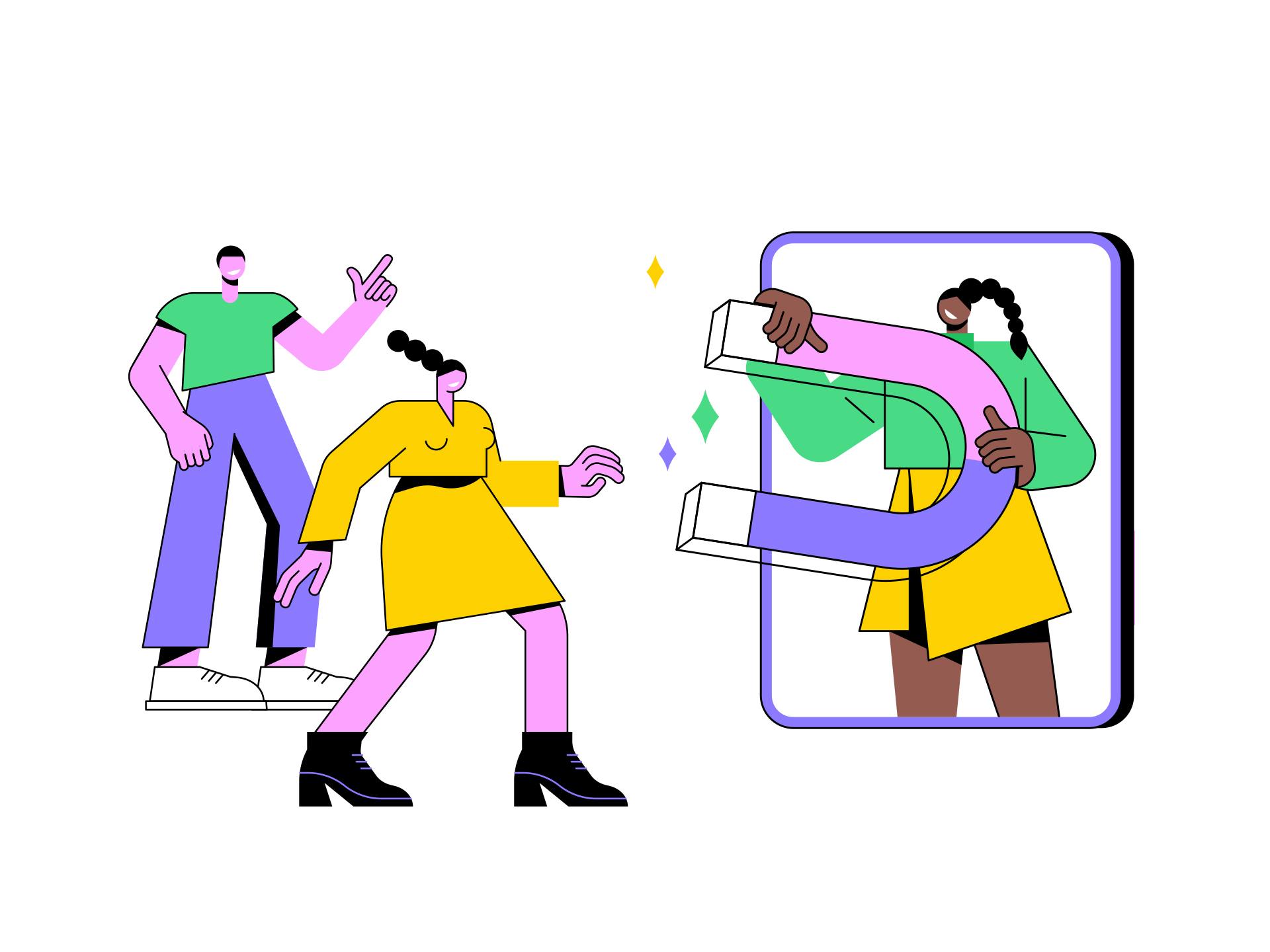In this article, we run down 9 strategies that you can implement to increase your brand loyalty. Brand loyalty is all about perception, as opposed to consumer loyalty, which is based on money. Customers are loyal to a brand when they feel that a particular brand equals superior quality.
1. Have personable and stellar customer service
Consumer expectations of brand experiences have dramatically increased, and one significant aspect of that is customer service. According to New Voice Media, 51% of customers will never do business again with a company after one negative customer experience. On a more positive note, a study by American Express uncovered that 7 out of 10 U.S. consumers say they have spent more money to do business with a company that delivers excellent service. Now customer service consists of many factors, including availability, reachability, and amicability, so customers expect customer service to be easy to reach, friendly, and responsive within two hours after the inquiry is made.
Tip: There are a variety of digital tools available to supplement human customer service and cut costs while increasing efficiency, including Chatbots (which you can quickly build through Botsify or Bottr) and email automation, such as Mailchimp.
2. Create engaging content
Eye-catching visuals and entertaining content are great ways to hold your customer’s attention for a few seconds longer than usual as they scroll through their cluttered feeds and maybe even give your post a 'like'. However, content that truly makes your consumer stay and think about your brand requires more. Do not be afraid to take a stance, invite people to share something about themselves, or ask a more in-depth question – topics that generate discussion. If branding is present throughout, even in conversations held on third-party websites such as Reddit, they will inevitably lead back to your brand.
A great example of this is Kellogg’s #GreatStarts campaign, where the cereal brand encouraged its users to share their morning rituals. Even though posts shared may not have had anything to do with the cereal, starting the morning right is linked right back to Kellogg’s value proposition and attracted celebrities such as Sir Steve Redgrave and Rebecca Adlington to market their brand for them without charge.
3. Build a community with your consumers
Consumers are people – they want to feel they belong, want to feel appreciated, want to feel like they are in the know, and want to gravitate towards other friendly people. When brands realise these needs of their consumer, they can effectively build deep and lasting relationships that translate into brand loyalty. Be frequent and consistent in your interactions with your consumers – the basics include replying to comments, sending personalised messages, and rewarding your consumers with perks and promotions through loyalty/rewards programs. According to Crowd Twist, 76% of women and 72% of men are likely to shop at a business that offers a loyalty program.
Tip: Beyond the basics, you may also exceed expectations and show appreciation by fulfilling unrelated wishes of your most loyal customers, such as giving a complimentary gift or hosting events for your consumers to meet and interact with each other. Genuine conversations between you and your consumers are meaningful, but your consumers’ communication with each other may serve to be even more potent in establishing brand loyalty.
4. Generate social proof
Word of mouth is one of the most cost-effective and high-converting methods of marketing. According to Big Commerce, 74% of consumers identify word of mouth as critical in their purchasing decisions. Creating a channel for consumer feedback, such as a review column, and encouraging users to post their testimonials on your website, social media, and third-party purchase or review channels is a great way to reinforce your brand and your product’s credibility. Furthermore, sharing user-generated content via your Facebook page, Instagram posts, or Snapchat stories will make users feel as if they are a valuable part of your company and thus more likely to incentivize others to create similar content.
Tip: According to the Digital Marketing Institute, over 49% of consumers consider key influencer recommendations when making purchasing decisions, and 40% of consumers had purchased something after seeing it on Twitter, YouTube, or Instagram. Key influencers tend to be bloggers and social media personalities with massive followings. Finding an influencer with a genuine passion for your product and a high engagement rate with their followers may be one of the best ways to generate social proof.

5. Design a smooth and personalised user experience
With companies such as Uber, Airbnb, and Amazon, users now expect seamless, intuitive, and personal UI/UX designs for every company. According to research from an Infosys study, 86% of consumers say that personalised designs can influence their purchasing decisions. On top of that, another 73% say they prefer to purchase from brands that use personal information for a more relevant shopping user journey. Apart from a stellar product, consumers gravitate towards companies that have easy-to-navigate websites or apps that provide a shortcut through the purchasing channel when compared to other websites.
6. Create a distinct value proposition
Product functionality and price point draw people to purchase the first time, but it is the emotional connection and personable identity of a brand that retains people to purchase from you repeatedly. As part of your brand strategy and positioning, a solid value proposition sets the foundation for communicating your brand’s identity.
A value proposition is essentially a short statement or paragraph that details what your brand’s values are, why you do what you do, and why people should care.
This statement should be based on your target audience's needs and desires – something they would identify with, aspire to or find exciting. Your mission statement, vision, tagline, voice, and visual language should then all bolster this statement to build a strong brand identity that your target audience will remember whenever the need for your products arises.
In the smartphone industry, brand loyalty and rivalry among users is infamous between two leaders: Apple and Samsung. In a SellCell survey of 2,066 smartphone users, 90.5% of current iPhone owners plan to stick with Apple the next time they upgrade, and 86% of Samsung users plan to do the same with Samsung. While both companies provide innovative and stylish smartphones in the form of the Apple iPhone and Samsung Galaxy series, Apple’s slight edge results from their unique value proposition focused on user experiences. The Apple iPhone is built around a clear value proposition: “A phone should be more than a collection of features. That, above all, a phone should be absolutely simple, beautiful, and magical to use.” Apple uses target marketing, research, and product design to match sleek, elegant designs with an integrated ecosystem emphasising the overall experience of using the device.
7. Create a distinct look and feel
Brand loyalty cannot exist without the ‘brand.’ Your brand is essentially your distinct, unique, and memorable identity or personality. But how is a brand conveyed to its consumers? Well, it is not too different from how we register the personalities of the people around us. We remember them by the way they look, the clothes they wear, the way they speak, the things they say, and the way they act. You can use the below questions to guide your basic brand creation.
Your brand’s visual appearance consists of several elements that can reinforce the personality of your brand in the mind of the consumer. Firstly, consider how your colour scheme can influence the impression of your brand. Bright and bold colours give off an energetic vibe while more muted and simplistic colours can be more sophisticated. For example, McDonald’s uses vibrant red and tallow brand colours to draw your attention to the Golden Arches. Other visual aspects include your photographic style, typeface, logo and others.
Following the appearance, determining a distinct tone of voice for your brand will make your identity even more personable. Do you want a voice that is more colloquial and amicable, or authoritative and informative? What kinds of words, adjectives and phrases do you want to associate with your brand? One brand that has stood out on tone alone is the fast-food favourite, Wendy’s, which has made a name for itself on social media with savage and cheeky roasts, garnering over 3.7 million followers for the brand on Twitter alone.
Tip: For companies that are not as design-savvy, there is a multitude of digital tools online at your disposal. For example, you can quickly generate cohesive colour palettes using Coolors or turn to Canva for user-friendly design templates for all of your visuals.

8. Maintain consistent branding
After creating your distinct brand identity, consistent delivery of your brand identity is the most crucial factor. Your consumers will be able to remember your brand and form a relationship with it through repeated exposure and impressions of the same visual language, tone of voice, and persona. This consistency can be challenging to maintain, especially if you have a larger company, many channels and touchpoints, use external marketing vendors, or experience any marketing staff turnover.
Tip: To ensure consistency internally within the company and externally in all consumer-facing materials, we often employ the use of a 'brand book,' also called a 'brand toolkit' or 'brand guidelines.' The brand book details everything from company values and colour palettes to placement of text and images. The marketing team, designers, and external vendors can then refer to the book to ensure consistency.
9. Ask for feedback, listen, and improve
Never stop asking for your customers' opinions, reflecting on their feedback, and applying it to your business. Addressing your consumers directly can inform you of the problems to solve, the desires to fulfil, and the challenges to keep in mind. It is also a gesture showing that you value and care for your customers' opinions, which is one of the most crucial factors in the development of brand loyalty. There are numerous ways to accomplish this, such as holding a competition, offering a reward in exchange for an answer to your question, providing a feedback channel on your website, emailing questionnaires, and creating focus groups.
Tip: Using tools such as Google Analytics, Facebook Audience Analytics, or Mixpanel, harness your digital channels to gain in-depth insights into your customer’s behaviour, relevant interests, or demographics, and predict what they want before they even tell you.
Conclusion
Ultimately, building brand loyalty is just part of brand strategy execution with marketing tactics. With that being said, modern consumers are flooded with an array of marketing messages and are much more aware of disingenuous marketing messages and value claims than ever before. An authentic brand will only be able to retain its customers and build long-term relationships if its branding values are rooted in something authentic and central to the founder or company's culture and values. By understanding what your company is about and how you genuinely bring value to your consumers, having authentic intentions to connect with your consumers, and maintaining an interactive community, can you then differentiate your brand as a human, personable, and memorable brand that consumers will want to advocate for and purchase from in the long run.

